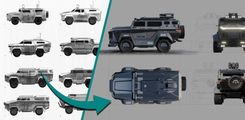Table of Contents
- Starting with the Brief
- Choosing an Architecture Style
- Rough Sketching: Fast, Loose, and Focused
- Building in 3D: Blocking, Scale, and Layout
- Adding Story with Detail
- Color and Material
- Lighting and Atmosphere
- Why Use 3D?
- Final Thoughts
How to Create Concept Art for Video Games: From Brief to Final Render
From gathering references to black-and-white sketches, to a final image, we share our techniques of creating concept art for video games.
Concept art isn’t just about creating beautiful images. It’s about purposeful, thoughtful design. Every element should clearly communicate its function to the player, whether it’s describing the use of a prop or the intent behind a specific building. While visual appeal matters, clarity is just as crucial. Players should be able to quickly understand what they’re looking at - whether something is friendly or threatening, an ally or an enemy.
In this post, we'll walk you through our entire process - from initial ideas to polished visuals - using a real-world example from a modern first-person shooter project.
Watch the full process on our YouTube Channel.
Starting with the Brief
Every great concept begins with a clear brief. Whether it's a professional assignment or a personal project, a brief anchors your creative direction. It organizes thoughts, gathers inspiration, and sets clear goals. Without it, even a simple request like “exterior casino architecture shot” could spiral into 50,000 creative directions - something we can't afford in a fast-paced game production environment.
For this project, the brief challenged us to design a map for a modern-day FPS level: a towering, exclusive casino owned by a warlord and weapons dealer. It needed to be more than aesthetically pleasing, it had to carry a story of wealth, power, and menace. The casino would be both fortress and symbol: a weaponized monument to corruption.
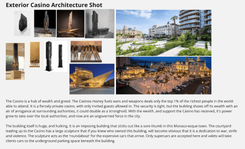
Choosing an Architecture Style
We chose brutalist architecture as the foundation. Its sharp angles and massive concrete forms project an unwelcoming, intimidating atmosphere which is ideal for a setting meant to feel dangerous. We studied real-world examples, including high-end casinos in Monaco, to explore how lighting and spatial flow work in these environments.
To elevate the design beyond typical architectural tropes, we looked for storytelling motifs. One particularly powerful idea was integrating sculptures of figures holding up the building - reminiscent of mythological punishments. These statues suggested a darker narrative: souls condemned to eternally support the empire of greed they unwittingly helped create. This symbolism gave the casino an underworld, almost Hades-like gravitas, further reflecting its owner's ruthlessness.
Rough Sketching: Fast, Loose, and Focused
We began with quick 2D sketches to explore form and shape language. Working in black and white allowed us to focus purely on silhouette and composition early on. These low-detail iterations helped confirm that brutalism was the right choice, and let us experiment with how the statues could be integrated structurally.
Once we had a variety of sketches, we chose three with the most aggressive, unfriendly forms with weapon-like architecture that reinforced the themes of violence and warfare from the owner. Avoiding circular or soft shapes which often are used for more friendly, peaceful narratives, we doubled down on sharp lines, repetition, and scale to enhance our storytelling elements.
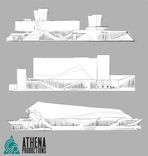
At this stage, it's about staying loose and being quick to explore as many ideas as we can.
Building in 3D: Blocking, Scale, and Layout
We transitioned into Blender to start blocking out the environment in 3D. Blockouts are crucial in game development as they allow you to test layout, gameplay flow, and scale early, before committing to detail. We selected a camera angle early in the process, which helped us establish lighting and composition.
It’s vital that early on you place a human-scale model into the scene to maintain accurate proportions. A small but essential step that avoids costly fixes later.
Our hero elements - the statues - were modeled from human figures, posed with slight variations, and decimated to achieve a monolithic, carved-stone look. We arranged them in odd numbers for visual balance, framing them as both structural supports and narrative symbols.
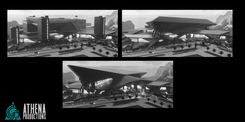
Adding Story with Detail
As the 3D layout took shape, we started refining key features like the courtyard. Inspired by Monaco and royal gardens, we crafted a manicured space that contrasted sharply with the brutalist surroundings. In the center, we placed an abstract sculpture hinting at the building’s violent history to add in another visual storytelling layer.
In Blender, we used matte painting techniques and photo textures to quickly add realism such as in the background with photos of distant cliffs and water. Anything closer to the camera, we use 3D from Megascans, Sketchfab, and CGTrader. Using Blender scatter add-ons we populated the scene with trees and grass efficiently, saving time without sacrificing quality.
Color and Material
We knew early on that our color palette needed to reflect the story of the Casino - so we went for obsidian and gold. Obsidian - dark and matte - captured the cold, intimidating tone of the architecture. Gold added a sense of opulence and greed, fitting for the casino’s purpose. A red carpet leading to the entrance suggested luxury and exclusivity, while carefully curated green gardens added balance, offering a vivid contrast of life within the otherwise criminal setting.
Each material choice reinforced the story. We avoided overly reflective, or bright colors to keep the design grounded and believable within the game world.
Lighting and Atmosphere
Lighting played a vital role in setting the mood and guiding the viewer's eye. We used an overcast atmosphere with cool blue and green tones to evoke a somber, foreboding ambiance. Warm light from windows created an eye-catching contrast, suggesting the casino was active and inhabited.
To further support storytelling, we added point lights along the driveway and emissive materials to windows - small details that made the environment feel alive. Fog and atmospheric effects are also important, so that you can separate the foreground, midground and background while also adding to the story.
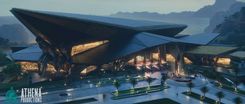
Why Use 3D?
3D proved invaluable throughout the process. It allowed us to iterate quickly, define architecture, lighting, and material choices early, and refine every visual aspect without the time heavy burden of 2D.
While 2D painting remains a powerful tool, the speed and flexibility of 3D made it far easier to produce production-ready concept art that’s both beautiful and practical.
Final Thoughts
From brief to final render, every decision we made served a single goal: to tell a compelling story through environment design. Whether it was the sharp angles of the building, the symbolism of the statues, or the interplay of color and light, each element helped build a world that players would not just see but feel.
That’s the power of concept art. It’s not just about creating something that looks cool, it’s about building worlds that are narratively rich and tell people how to feel, long before a player ever picks up the controller.
Creating environment concept art that isn't just aesthetically pleasing, but is also functional is a vital skill, and one that our experienced team of concept artists has provided to video games from indie to AAA.
If you’re looking to create unforgettable environments, our concept art studio is ready to bring your vision to life with exceptional design, emotion, and storytelling. Discover how our team can help today!
